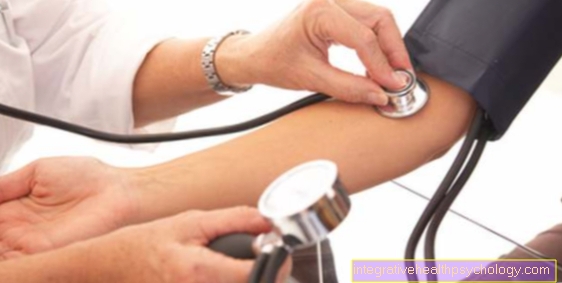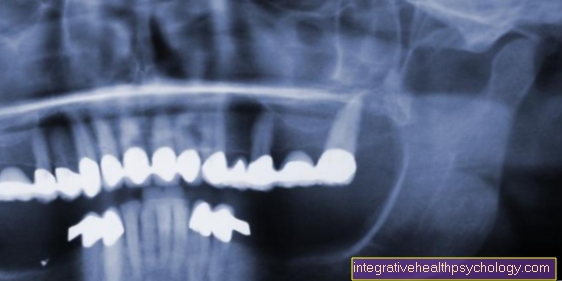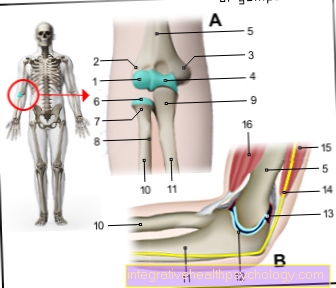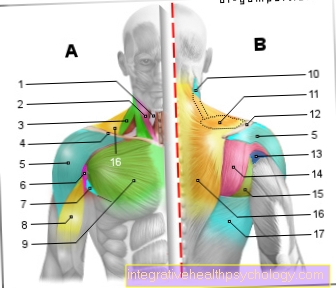How can you prevent a heart attack
General
Nowadays, heart attacks and strokes are the most common cause of death in industrialized countries before any cancer. This is mainly due to our way of life, which is characterized by a lack of exercise, stress and poor nutrition. The most important risk factors such as obesity, high blood pressure, diabetes, smoking and lack of exercise are actually easy to avoid or treat. The following article describes exactly how a heart attack can be prevented.

These measures prevent a heart attack
-
Stop smoking. The ingredients in tobacco smoke attack the coronary arteries directly and damage them.
-
Regular blood pressure checks by your doctor or at home. Treatment of high blood pressure with medication (see below)
-
If you are diabetic, the risk is particularly high. It is then all the more important to adjust the blood sugar correctly.
-
Regular monitoring of blood lipid levels (cholesterol, LDL) and treatment of excessively high levels.
-
Weight loss if you are overweight, avoiding excessive sugar and fat consumption. The so-called Mediterranean diet is recommended.
-
Alcohol contains a lot of calories that are converted directly into fat, although there is no need to state the number of calories on the bottles!
-
Stress is a known risk factor. It is often not easy to “switch off” stress. However, one can learn to better "withstand" stress through relaxation techniques, sport and hobbies.
-
Regular sport, especially endurance sport (see below) can also reduce the risk of heart attacks.
-
Avoiding drugs that increase the risk of heart attacks, such as painkillers that end with -coxib.
Exercise to prevent a heart attack
Probably the most important way to prevent a heart attack is through regular exercise. Endurance sports in particular have many positive effects on the body. On the one hand, the constant long-term stress, such as is given when jogging, swimming or even walking, activates the body's fat reserves and thus prevents or counteracts excess weight. This is especially useful in view of the fact that obesity is one of the strongest risk factors for developing a heart attack. There are several reasons for this. On the one hand, the additional body weight places a heavy burden on the heart, since high blood pressures and heart rates are now necessary so that the heart can continue to ensure an adequate supply of the body. Furthermore, being overweight is evidence of an unhealthy fat metabolism and sooner or later leads to vascular calcification (arteriosclerosis). This is also promoted by type II diabetes mellitus, which is closely related to being overweight. After all, moderate endurance sport also ensures good training of the heart, which reacts to the healthy stress with a growth of the heart muscle cells and an expansion of the blood vessels.
Endurance training against heart attack
Regular endurance training is an important pillar of heart attack prevention, even if you've already had a heart attack. It strengthens the muscles, promotes blood circulation in the heart, helps to reduce weight and blood sugar and can also entice people to do joint activities and be fun in cardiac sports groups!
As a guide, you can start by doing half an hour of endurance training several times a week (3 - 5 times). This includes hiking, jogging, Nordic walking, cycling, swimming, aqua aerobics, rowing or skiing. Of course, the choice of sport depends on any illnesses you may have, such as osteoarthritis of the knee joint. Many of these activities can be carried out in gyms even in bad weather. Health insurance companies often support such projects and can help find suitable training locations. Before you start exercising seriously and regularly, an examination by your doctor is recommended.
Also read our topic: Endurance sports
Diet to prevent heart attack
One of the most important measures to prevent heart attacks is a healthy diet. One of the main reasons why heart attacks are so prevalent in Western society is our fatty and meaty diet, which increases blood cholesterol levels. However, a distinction must be made here between "good" HDL cholesterol and "bad" LDL cholesterol. The former has a very positive effect on our fat metabolism and the condition of our blood vessels and can be increased in a targeted manner by consuming more vegetable oils instead of animal fats. Olive oil in particular is an important basis for a heart-friendly diet, as it is rich in unsaturated fatty acids. The best-known representative of unsaturated fatty acids is probably the much-advertised omega-3 fatty acid. Palm and coconut oils, on the other hand, are not recommended, although they are vegetable. Fish also contains a lot of unsaturated fatty acids.
LDL cholesterol, on the other hand, is usually increased when a lot of meat and eggs are eaten. A permanently increased blood LDL level results in "vascular calcification" (arteriosclerosis), which leads to a narrowing of the diameter of the blood vessels and thus increases the likelihood of a heart attack. In addition, the general rules of a balanced diet apply to a heart attack preventive diet. Above all, the copious consumption of high-fiber foods such as vegetables and fruit should be mentioned.
You might also be interested in the following topic: Diet for heart disease
Recommended foods
Making the right food choices in your diet is one of the most important steps in a heart attack preventive lifestyle. As already described in the "Diet" section, it is particularly important to bring foods onto the menu that are high in unsaturated fatty acids and fiber. Italian is considered to be one of the healthiest kitchens ever. This is mainly due to the abundant use of vegetable oils, especially the olive oil. In contrast to butter, which is widely used in German cuisine, this ensures a high HDL cholesterol level in the blood, which has a very positive effect on the health of the blood vessels. Nuts and fish also contain many unsaturated "healthy" fatty acids. Apart from that, however, a low-fat diet is recommended.
Above all, however, the frequent consumption of red meat, such as beef and pork, should be avoided, as this increases the LDL cholesterol level. Unlike HDL cholesterol, this has a negative effect on our vessels by promoting vascular calcification (arteriosclerosis), which in most cases is the basis of heart attacks.
Vegetables and fruits are also high on the list of foods that help prevent heart attacks. These are rich in fiber, minerals and vitamins and contain hardly any calories. An abundant consumption of low-fat vegetable foods can prevent obesity and thus, by relieving the heart, also prevent heart attacks.
Finally, it is worth mentioning the incorporation of complex carbohydrates into the diet, which are mainly contained in foods such as whole grain products. These take a much longer time to break down and therefore keep you full longer. Simple sugars, such as those found in sweets, are known to promote obesity and diseases such as diabetes mellitus - two of the greatest risk factors for a heart attack.
Also read our topic: Diet for high blood pressure
What about red wine?
A moderate consumption of red wine is often generally attributed to a health-promoting effect. Red wine is said to have a protective effect especially on the cardiovascular system and thus also prevent heart attacks. According to the current state of research, this is most likely due to the polyphenols contained in some red wine varieties, which belong to the group of antioxidants. High polyphenol contents can be found especially in the Tannat variety. In addition, red wine also contains other antioxidants, such as resveratrol. In addition to their preventive effect on heart attacks, antioxidants also help to prevent cancer.
Some studies also confirm that alcohol itself has a healthy effect on the body as long as alcohol consumption is limited to a very small amount per day. However, when consuming alcohol, for whatever purpose, its negative consequences should always be kept in mind. Alcohol consumption, even in small amounts, increases the likelihood of suffering from a variety of medical conditions. These include above all cancers such as larynx and floor of the mouth cancer. A critical consideration of your own red wine and alcohol in general is therefore definitely appropriate.
What role does cholesterol play?
The origin of atherosclerosis, popularly known as “calcification”, has not yet been fully clarified. However, a decisive step is the storage of cholesterol crystals in the already damaged vessel wall. Phagocytes (Macrophages) try to remove these deposits, but fail and perish in the attempt. A chronic inflammation of the vessels forms, which gradually constricts the vessel as plaque, or is "peeled off" and then clogs the vascular segment behind. A high supply of cholesterol, which is present as lipoproteins (e.g. low density lipoprotein, LDL) in the blood, consequently leads to more deposits.
It is known from large scientific studies that high cholesterol levels are related to the occurrence of heart attacks and survival time. Drugs like statins, which lower cholesterol, also lower the risk of having a heart attack. In addition to lowering cholesterol, statins' anti-inflammatory effects may also play a role in preventing heart attacks.
You might also be interested in this topic: Foods and cholesterol
Medicines to prevent a heart attack
Preventing a heart attack includes adjusting blood pressure, blood sugar and blood lipids. Often you have to use medication for this. This is recommended if a change in lifestyle and diet does not work.
If the coronary arteries are already narrowed (coronary artery disease, CHD), it is advisable to regularly take Aspirin® in small doses (100 mg per day) to inhibit platelet clumping and a statin to reduce blood lipids and "stabilize" the deposits in the coronary vessels to take. Chest pain (angina pectoris) is treated with long-term use of beta blockers. These ensure that the heart uses less oxygen and “starves” less for oxygen. Nitrates are often prescribed for acute pain. These drugs dilate the coronary arteries and increase the supply of oxygen. One example is glizerol trinitrate, which is available as a spray. Under no circumstances should this be taken with sexual enhancers such as sildenafil (Viagra), as dangerous drops in blood pressure can occur in combination.
You might also be interested in this topic: Medicines for high blood pressure
Aspirin®
Acetylsalicylic acid (ASA) is a widely used pain reliever, which also has antipyretic, anti-inflammatory and anti-blood clotting properties. Colloquially, it is often referred to as Aspirin®, although strictly speaking this is only one of many brand names for drugs containing ASA. In addition to its use for pain relief in doses of 0.5 to 2g, it is used in lower doses of usually 100mg for the prevention of heart attacks and strokes.
It acts by inhibiting the enzyme cyclooxygenase-1 (COX-1), which is contained in the blood platelets (thrombocytes), inhibiting coagulation. This effect lasts for several days. Aspririn prevents the formation of blood clots (thrombi). In combination with vascular calcifications, these are usually the cause of heart attacks by occluding the coronary arteries and thus causing insufficient blood flow in the heart muscle tissue, which ultimately inevitably leads to the death of the muscle.
However, regular intake of ASA over a longer period of time is associated with a number of side effects. One of the most common complaints is his poor stomach tolerance. Since aspirin stimulates gastric acid production, it provokes long-term irritation of the gastric mucosa and significantly increases the likelihood of a gastric ulcer. For this reason, aspirin is usually prescribed along with a "stomach protection" drug, such as the widely used pantoprazole. Other possible side effects are impaired kidney function and, logically, an increased tendency to bleeding.
Read more on the topic: Aspirin®
EKG for diagnosing a heart attack
An electrocardiogram (EKG) is a record of the electrical activity of all heart muscle fibers. It represents a very uncomplicated, fast and non-invasive diagnostic method with which the heart activity and possible disturbances can be recognized. If a heart attack is suspected, it is standard procedure to diagnose it. Cardiac arrhythmias, which represent a risk factor for the development of a heart attack, can also be diagnosed and circulatory disorders in the context of coronary artery disease (CHD) can be recognized.
A CHD is a narrowing of the coronary arteries and can be viewed as a precursor to a heart attack. In order to be able to make a reliable diagnosis, a stress ECG can be written in addition to a simple resting ECG. Here, the heart activity is observed during physical exertion. This is usually done on an ergometer, i.e. a stationary bike, on which the pedaling resistance is gradually increased. Under this load, circulatory disorders of the heart show up even more clearly than in an electrocardiogram. Another possibility of carrying out a more detailed examination of the heart's activity is finally to create a long-term EKG, in which an EKG is written over 24 hours. The equipment required for this is quite small and can be worn around the neck so that the patient is not restricted in his everyday activities.
Therapy after a heart attack
The therapy of an acute myocardial infarction is extensive and includes a number of medications, as well as often the use of a cardiac catheter to reopen the blocked vessel. The most important prerequisite for the healing of the damaged myocardial cells is and remains a timely recognition of the symptoms of a heart attack. Every minute matters; The faster treatment can begin, the less the consequential damage caused by the infarction.
However, curing the underlying problems and diseases that cause heart attacks is a complex matter. A heart attack is usually the result of irreversible damage to the coronary arteries. Bypass operations, in which the blood supply to the heart muscle is secured by inserting new blood vessels, or by inserting stents, can in some cases avoid the recurrence of heart attacks. However, to ensure this is also guaranteed in the future, it is necessary to change your own bad habits. This is the only way to be certain that you will not have another heart attack.
Also read our topic: Therapy of a heart attack
Insertion of a stent as therapy for a heart attack
If a relevant narrowing is found during a cardiac catheter examination, be it during an examination for a coronary artery disease or during a heart attack, the cardiologist can use a thin wire to locate the narrowing and expand it with a balloon. A small wire cylinder (stent) is inserted so that the stretched area remains open. The innermost layer of the blood vessels can grow back in through the cage-like openings in the cylinder and line the stent. Until this happens, platelet function inhibitors must be taken, because otherwise these would be activated by the "bare" cage and block the stent. The cardiologist will decide how long the platelet inhibitor must be taken based on the type of stent used.
You might also be interested in the following topic: Implantation of a stent after a heart attack
Home remedies to prevent a heart attack
A heart attack is a serious risk and should never be treated solely with home remedies and naturopathic methods. However, for example, soothing teas can contribute to well-being and healthy sleep and thus reduce stress.
Individual dietary supplements are often recommended, such as fish oil containing omega-3 fatty acids, which is said to have anti-inflammatory effects. Vitamins and trace elements should also be supplied in sufficient quantities. In other sources, certain foods, such as garlic, are sworn in. It is crucial not to bet on one menu, but rather to develop an overall concept of varied nutrition based on the Mediterranean diet and sufficient exercise.
Heart attack risk - how can you assess your risk?
Risk calculators (so-called scores) are available for assessing the risk of heart attack and can be accessed via the Internet. Examples of this are the PROCAM score, the ESC score or the Framingham score. These are scientifically justified and therefore preferred to other, less serious risk calculators. Blood pressure and blood lipid values are usually necessary for the calculation, so that these scores are usually calculated during a visit to the doctor, for example at the family doctor during the check-up. Using the PROCAM score, you can calculate how high the risk of a heart attack or stroke will be within the next 10 years. This in turn determines which treatment is used to reduce the risk. If you belong to the high-risk group (over 20% risk in the next 10 years) a prescription of medication is necessary, whereas if you are at lower risk you can wait and try to change your lifestyle and your diet first.
Symptoms of a heart attack in women
In general, women are much less likely to have heart attacks than men. This is mainly due to the unhealthy way of life of the male sex, which is more prone to nicotine and alcohol consumption, as well as the consumption of fatty foods. Nonetheless, heart attacks are one of the most common causes of death, along with strokes, among women in industrialized countries.
It is important to note that the symptoms of a heart attack can differ between women and men. In addition to classic early warning signs such as pain in the chest area and on the inside of the left arm, unspecific complaints such as shortness of breath, nausea and vomiting are also increasingly common in women. Even the pain in the chest area can have a different character and is characterized less as severe pain and more as a kind of pressure and resistance.
It should also be mentioned that the likelihood of a heart attack in women increases with the onset of menopause, as the production of the vascular protective female hormones is no longer fully guaranteed during this period. Taking hormone preparations therefore makes sense. Unfortunately, studies on this have come to the conclusion that, for unexplained reasons, hormone administration does not offer any protection against heart attacks.
Also read our topic: Heart attack in women





























